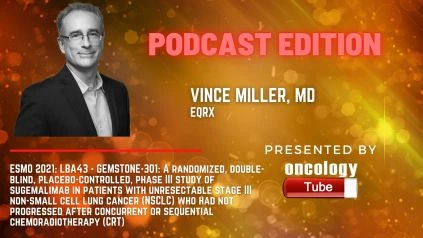Vince Miller, MD is one of the world’s experts in lung cancer and clinical trial design and interpretation. His work was critical to identification of EGFR sensitizing and resistance mutations, Physician-in-Chief at EQRx speaks about the ESMO 2021 Abstract – LBA43 – GEMSTONE-301: A randomized, double-blind, placebo-controlled, phase III study of sugemalimab in patients with unresectable stage III non-small cell lung cancer (NSCLC) who had not progressed after concurrent or sequential chemoradiotherapy (CRT).
Background:
The standard of treatment for patients (pts) with unresectable stage III NSCLC is concurrent CRT (cCRT) followed by immunotherapy. However, because almost half of this group is unable to handle cCRT, sequential CRT (sCRT) is frequently used. A phase 3 study was performed to assess sugemalimab, a full-length, completely human IgG4 monoclonal antibody targeting PD-L1, as consolidation therapy in patients with stage III NSCLC who had not progressed after cCRT or sCRT. This is the first phase 3 experiment in this context to include both populations.
Methods:
Patients were divided by ECOG performance status (0 vs 1), CRT type (cCRT vs sCRT), and total RT dosage (60 Gy vs 60 Gy) and were randomized 2:1 to receive sugemalimab 1200 mg or placebo Q3W. By blinded independent central review pursuant to RECIST v1.1, the main outcome was progression-free survival (PFS).
Results:
33.3 percent of the 381 patients randomized from 50 locations had previously undergone sCRT, 69.6% had an ECOG performance level of 1, 69.0% had squamous cell carcinoma, and 28%/55 percent/16% had stage IIIA/IIIB/IIIC illness. The median PFS with sugemalimab was 9.0 months vs 5.8 months with placebo at the pre-planned interim analysis with a median follow-up of 14 months (HR 0.64; 95 percent CI 0.48–0.85; P=0.0026). The 12-month PFS rates were 45 percent vs. 26 percent, and the 18-month PFS rates were 39 percent vs. 23 percent, respectively. PFS advantage was consistent regardless of whether patients had previously had sCRT (median PFS 8.1 vs 4.1 months, HR 0.59) or cCRT (median PFS 10.5 vs 6.4 months, HR 0.66). Overall survival (OS) statistics were inconclusive, however, there was a tendency in favor of sugemalimab (HR 0.44; 95 percent CI 0.27–0.73). The 12-month and 18-month OS rates were 89 percent and 76 percent, respectively, and 82 percent and 60 percent. Treatment-emergent adverse events of grade 3 occurred in 24.3 percent of sugemalimab patients and 23.8 percent of placebo patients.
Conclusions:
With a well-tolerated safety profile, sugemalimab showed a statistically significant and clinically relevant increase in PFS when compared to placebo. These findings support the use of sugemalimab as consolidation therapy for patients with unresectable stage IIIA–C NSCLC who have not progressed after cCRT or sCRT.
Clinical trial identification
NCT03728556.

